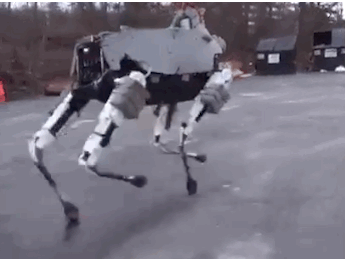The American military has long dreamed of an automated force, though it was only a publicity stunt during the Jazz Age when robots “joined” the army. Since then, powerful tools emerged and were miniaturized, ultimately sliding low-priced supercomputers into almost every pocket. Now when it comes to making our fighting machine an actual machine, anything seems possible–or may soon be.
Even if we remain in control of the strategic decisions governing these new warriors, the mere presence of “unkillable” battalions will likely come to bear on our thinking. Sooner or later, with several well-funded nations vying for supremacy, mission creep could remove the controls from human hands.
In “Our New War Machines,” Scott Beauchamp’s Baffler piece, the Army veteran and writer says this shift from carbon to silicon soldiers will result in “less democratic oversight of the American military.” The opening:
For an institution synonymous with tradition and continuity, the American military is in quite a radical state of flux. In just the six or so years since I left the Army, two major demographic shifts that might superficially appear unrelated (or even contradictory) have taken place within the Department of Defense. The first of these transformations involves opening up the ranks of service to previously excluded or marginalized populations: bringing women soldiers into all combat roles, allowing gay and lesbian personnel to serve openly, repealing the ban on trans people in the military.
The other major change, known in the defense industry and milblog enclaves as the Third Offset Strategy, involves taking the human element out of combat entirely. Third Offset focuses on using robots to automate warfare and reduce human (or at least American human) exposure to combat. So at the same moment that more people than ever are able to openly serve in the United States military and find the level of service best suited to their talent and abilities, fewer people are actually necessary for waging war.
The “offset” terminology itself signals the projected scale this transformation. In Pentagon-ese, an offset denotes a strategy aimed at making irrelevant a strategic advantage held by enemy forces. The first modern offset was the exploitation of American’s nuclear arsenal in the 1950s to compensate for the Warsaw pact participants’ considerable manpower advantage. The second offset was likewise geared toward outsmarting the Soviet war machine once it had gained roughly equivalent nuclear capabilities; it involved things like stealth technology, precision-guided munitions, and ISR (intelligence, surveillance, and reconnaissance) platforms. But forty years on, our “near-peer” competitors, as the defense world refers to China and Russia, have developed their own versions of our second offset technologies. And so something new is needed; hence the Pentagon’s new infatuation with roboticized warfare.•
Tags: Scott Beauchamp

